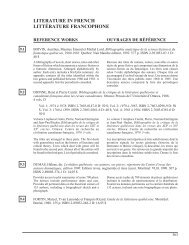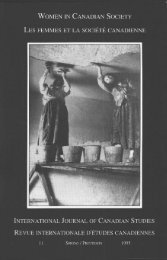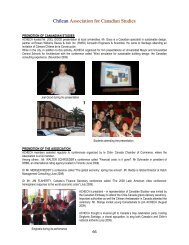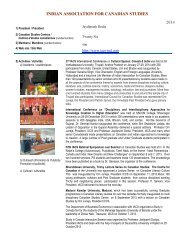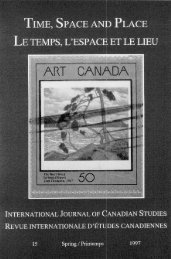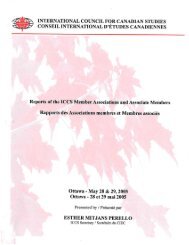Arts and Literature in Canada:Views from Abroad, Les arts et la ...
Arts and Literature in Canada:Views from Abroad, Les arts et la ...
Arts and Literature in Canada:Views from Abroad, Les arts et la ...
- No tags were found...
You also want an ePaper? Increase the reach of your titles
YUMPU automatically turns print PDFs into web optimized ePapers that Google loves.
The Architecture of Arthur Erickson: Redeem<strong>in</strong>g ModernityP<strong>la</strong>c<strong>in</strong>g Erickson <strong>in</strong> the Project of ModernityFor all <strong>in</strong>tents <strong>and</strong> purposes, Erickson is an <strong>in</strong>heritor of the project ofmodernity, an enterprise dat<strong>in</strong>g to the 18th century. His professional tra<strong>in</strong><strong>in</strong>g atMcGill University was cast <strong>in</strong> the then <strong>in</strong>fluential mode of the Bauhaus. Whenhe entered architectural practice <strong>in</strong> Vancouver <strong>in</strong> 1953, a mature modernism,the International Style, was emerg<strong>in</strong>g forcefully <strong>in</strong> North America. Of course,modernism is a self-conscious term, atta<strong>in</strong><strong>in</strong>g mean<strong>in</strong>g <strong>from</strong> how an era viewsitself <strong>in</strong> re<strong>la</strong>tion to its past. 4 Complicat<strong>in</strong>g the issue, modernism <strong>in</strong> architecture<strong>and</strong> the “Modern Movement” are readily conf<strong>la</strong>ted.Rooted <strong>in</strong> the Enlightenment, modernism postu<strong>la</strong>ted universal pr<strong>in</strong>ciples ofart, science <strong>and</strong> morality based upon the autonomous <strong>la</strong>ws of their <strong>in</strong>ner logic.As a <strong>la</strong>rger enterprise, it has been manifested diversely <strong>in</strong> cont<strong>in</strong>ually evolv<strong>in</strong>garchitectural expressions <strong>from</strong> Romantic C<strong>la</strong>ssicism to the high VictorianGothic, evident <strong>in</strong> <strong>Canada</strong> <strong>from</strong> British colonial c<strong>la</strong>ssicism to the VictorianDom<strong>in</strong>ion Parliament Build<strong>in</strong>gs. Dur<strong>in</strong>g the first decades of the 20th century,the project of modernity reached new extremes by exalt<strong>in</strong>g the present <strong>and</strong>revolt<strong>in</strong>g aga<strong>in</strong>st the normative functions of history. This spirit was embodied<strong>in</strong> parallel, y<strong>et</strong> dist<strong>in</strong>ct, architectural expressions—the DeStijl, Futurist, <strong>and</strong>Bauhaus styles <strong>in</strong> Europe, <strong>and</strong> the manner of Frank Lloyd Wright <strong>in</strong> NorthAmerica—which tog<strong>et</strong>her constitute the so-called Modern Movement,culm<strong>in</strong>at<strong>in</strong>g <strong>in</strong> the International Style.In their <strong>in</strong>dictments of 20th-century modernism's utopian presumptions,<strong>in</strong>difference to context, <strong>and</strong> f<strong>et</strong>ishiz<strong>in</strong>g of production, proponents ofpostmodernism have been notorious for present<strong>in</strong>g a monolithic picture of amodern architecture that was not merely hegemonic—the normative productof a dom<strong>in</strong>ant track of aesth<strong>et</strong>ic <strong>and</strong> cultural theories, but absolutelyhomogenous. 5 Such a mythic modernism never existed, particu<strong>la</strong>rly not <strong>in</strong>North America where, as Huyssen (1986, p. 185) po<strong>in</strong>ted out, the <strong>in</strong>itialutopian visions of modernism were never <strong>in</strong> favor <strong>and</strong> the promotion of theInternational Style was the result of corporate <strong>and</strong> governmententrepreneurship. This is especially true of <strong>Canada</strong>, where modernism, whichatta<strong>in</strong>ed its apex <strong>in</strong> the architecture of the 1960s, was <strong>la</strong>te to triumph. The<strong>in</strong>herent brutality <strong>and</strong> p<strong>la</strong>celessness of modernism's mach<strong>in</strong>e aesth<strong>et</strong>ic isapparent <strong>in</strong> such prom<strong>in</strong>ent works of Canadian architecture as the P<strong>la</strong>ceBonaventure by Afflect, Desbarats, Dimakpoulos, Lebensold, Sise (Montreal,1967), <strong>and</strong> through the sem<strong>in</strong>al works of John Park<strong>in</strong> <strong>in</strong> association with Miesvan der Rohe for the Toronto Dom<strong>in</strong>ion Bank (Toronto, 1964-72) <strong>and</strong> withViljo Revell for the Toronto City Hall (1965). The development of such awider framework is critical for position<strong>in</strong>g Erickson <strong>in</strong> the project ofmodernity, <strong>and</strong> the discourse that progressively challenged its authority.While Erickson appreciated the modern ideals of structural honesty <strong>and</strong> formalefficiency, an <strong>in</strong>tuitive response to environmental context is evident <strong>in</strong> hisbuild<strong>in</strong>gs as early as the first Smith House (West Vancouver, B. C., 1953) <strong>and</strong>29



